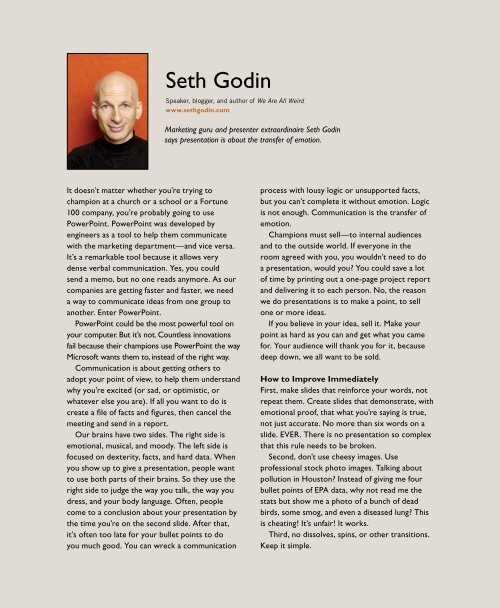Making-Original-Products-presentationzen
You also want an ePaper? Increase the reach of your titles
YUMPU automatically turns print PDFs into web optimized ePapers that Google loves.
Seth Godin<br />
Speaker, blogger, and author of We Are All Weird<br />
www.sethgodin.com<br />
Marketing guru and presenter extraordinaire Seth Godin<br />
says presentation is about the transfer of emotion.<br />
It doesn’t matter whether you’re trying to<br />
champion at a church or a school or a Fortune<br />
100 company, you’re probably going to use<br />
PowerPoint. PowerPoint was developed by<br />
engineers as a tool to help them communicate<br />
with the marketing department—and vice versa.<br />
It’s a remarkable tool because it allows very<br />
dense verbal communication. Yes, you could<br />
send a memo, but no one reads anymore. As our<br />
companies are getting faster and faster, we need<br />
a way to communicate ideas from one group to<br />
another. Enter PowerPoint.<br />
PowerPoint could be the most powerful tool on<br />
your computer. But it’s not. Countless innovations<br />
fail because their champions use PowerPoint the way<br />
Microsoft wants them to, instead of the right way.<br />
Communication is about getting others to<br />
adopt your point of view, to help them understand<br />
why you’re excited (or sad, or optimistic, or<br />
whatever else you are). If all you want to do is<br />
create a file of facts and figures, then cancel the<br />
meeting and send in a report.<br />
Our brains have two sides. The right side is<br />
emotional, musical, and moody. The left side is<br />
focused on dexterity, facts, and hard data. When<br />
you show up to give a presentation, people want<br />
to use both parts of their brains. So they use the<br />
right side to judge the way you talk, the way you<br />
dress, and your body language. Often, people<br />
come to a conclusion about your presentation by<br />
the time you’re on the second slide. After that,<br />
it’s often too late for your bullet points to do<br />
you much good. You can wreck a communication<br />
process with lousy logic or unsupported facts,<br />
but you can’t complete it without emotion. Logic<br />
is not enough. Communication is the transfer of<br />
emotion.<br />
Champions must sell—to internal audiences<br />
and to the outside world. If everyone in the<br />
room agreed with you, you wouldn’t need to do<br />
a presentation, would you? You could save a lot<br />
of time by printing out a one-page project report<br />
and delivering it to each person. No, the reason<br />
we do presentations is to make a point, to sell<br />
one or more ideas.<br />
If you believe in your idea, sell it. Make your<br />
point as hard as you can and get what you came<br />
for. Your audience will thank you for it, because<br />
deep down, we all want to be sold.<br />
How to Improve Immediately<br />
First, make slides that reinforce your words, not<br />
repeat them. Create slides that demonstrate, with<br />
emotional proof, that what you’re saying is true,<br />
not just accurate. No more than six words on a<br />
slide. EVER. There is no presentation so complex<br />
that this rule needs to be broken.<br />
Second, don’t use cheesy images. Use<br />
professional stock photo images. Talking about<br />
pollution in Houston? Instead of giving me four<br />
bullet points of EPA data, why not read me the<br />
stats but show me a photo of a bunch of dead<br />
birds, some smog, and even a diseased lung? This<br />
is cheating! It’s unfair! It works.<br />
Third, no dissolves, spins, or other transitions.<br />
Keep it simple.



